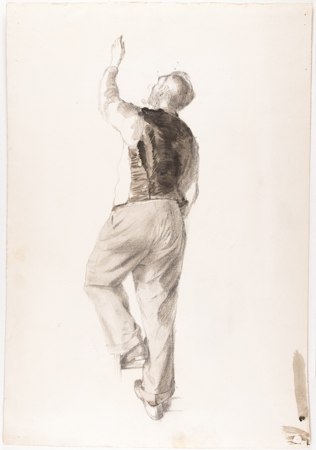
Design for 'The King's Stamp', November 1935.
Unmounted (ref: 8889)
Pencil, gouache, collage
Tags: Barnett Freedman collage/photomontage gouache pencil design portraits 1.Master Designs

Tags: Barnett Freedman collage/photomontage gouache pencil design portraits 1.Master Designs
Provenance: The Artist's family
The seven pence design was eventually used for the Silver Jubilee stamp of the same year, issued in four different colours.
Freedman gained considerable acclaim for his stamp designs, a phenomena greatly aided by the 1935 film, The King's Stamp, directed by William Coldstream with music by Benjamn Britten, produced by Alberto Cavalcanti under the auspices of the GPO Film. Commissioned as part of King George V's Silver Jubilee celebrations in 1935, the film opens with Freedman sketching designs before working freehand to produce a lithostone. In the second section, Freedman's relaxed dealings with senior GPO officials are contrasted with Rowland Hill's struggles to introduce the penny post'. Hill gets his way eventually, but the public still struggle with the idea of stamps. Victorian England is depicted as snobbish and illiterate, quite unlike the modern Britain run by the clever managers and innovators of the interwar years. As the stamp is being printed, the film turns from black and white to colour.
The final part of the film looks at the rise of stamp collecting, a democratic hobby enjoyed by the young and old of all classes. The film ends with stills from King George V's private stamp collection. The King's interest in stamp collecting was a part of his public appeal and it did not escape the King's notice that his Silver Jubilee, on the 6th May, was exactly 95 years after the first Penny Black.
During George V’s 26 year reign (1910-1936) only three definitive stamp designs were issued – the Downey Head, the Mackennal (or Profile) Head and the Seahorse High Values.
According to the Postal Museum website:
The idea of producing commemorative stamps to mark the Silver Jubilee of King George V originally came from the Colonial Office, with the suggestion that an identical set should be issued throughout the Empire on 10 May 1935. The Post Office was initially unenthusiastic, as work was underway on a new set of definitives, and it was known that the King did not particularly approve of commemorative issues.
However, the Director of Postal Services eventually agreed that this was the best way for the Post Office to participate in the Jubilee celebrations, and in June 1934 it was decided that four values, ½d, 1d, 1½d and 2½d, should be issued.
Selection consultations took place between Colonel Sir Donald Banks, Director General, Sir Stephen Tallents, GPO Public Relations Officer, and Kenneth Clark, Director of the National Gallery. Artists were invited to submit designs for one value, with a view to producing designs for the full set if selected.
As this would be the first special issue to be produced by photogravure, which reproduces a number of graduated tones, designs were requested in shades of grey. The GPO suggested royal homes, buildings, scenes and events of Imperial significance as possible subjects.
Twelve designs were submitted unsuccessfully, but a second round of submissions produced one satisfactory design, which was by Barnett Freedman. This was essayed using alternative portraits of the George V, by Vandyk and Mackennel, and in two sizes. The King chose the Mackennel head, on landscape stamps twice the size of standard definitives.
The chosen colours corresponded with the definitives. Thoughts had been given to issuing the 2½d in turquoise (known to collectors as ‘Prussian blue’) instead of ultramarine: essays were produced, but the idea was abandoned. However, Harrisons inexplicably printed many sheets in the incorrect colour. Most were destroyed, but five were delivered to the Stores Department, and at least three were accidentally issued to Upper Edmonton Post Office, where they were sold in the normal way.
The stamps were issued on 7 May 1935 in sheets, and, with the exception of the 2½d value, in 2/- and 3/- booklets. The booklet panes comprised four stamps, and the covers were also designed by Freedman. The stamps were also overprinted for use in the Morocco Agencies and Tangier.
There is a study of a standing figure, drawing, on the reverse of this sheet. .

And examples of the Jubilee stamps

A similar design is in the collection of the Victoria and Albert Museum.